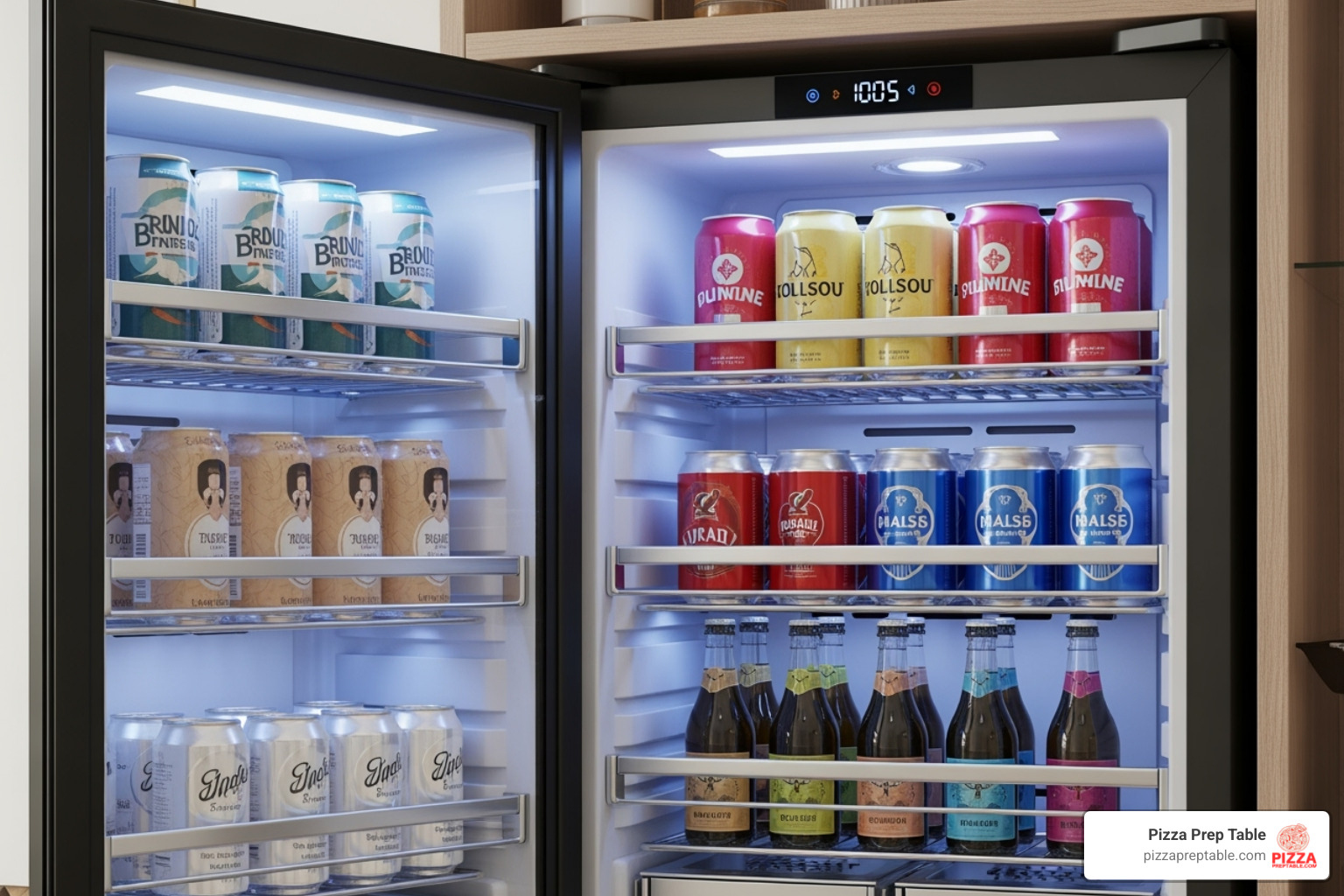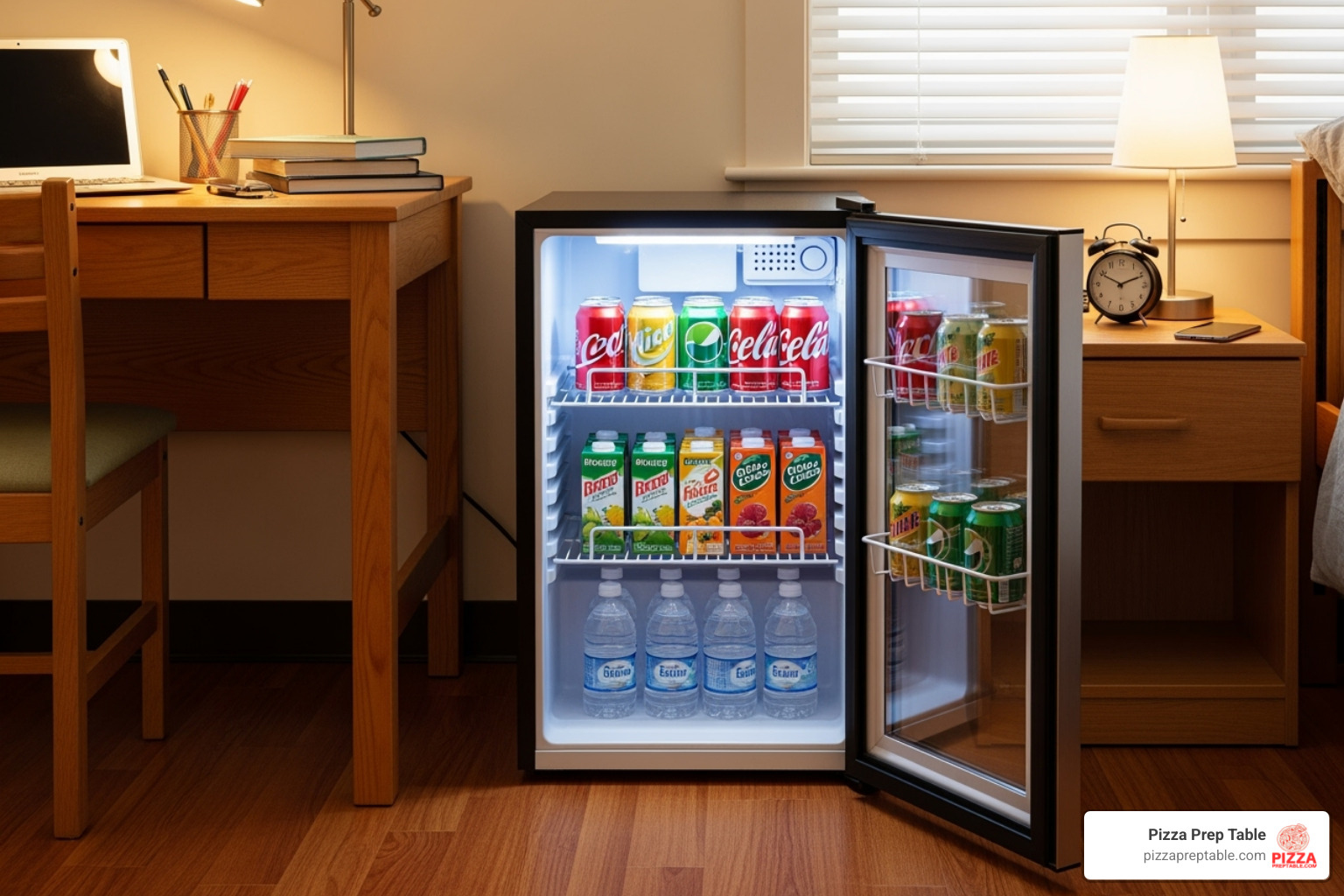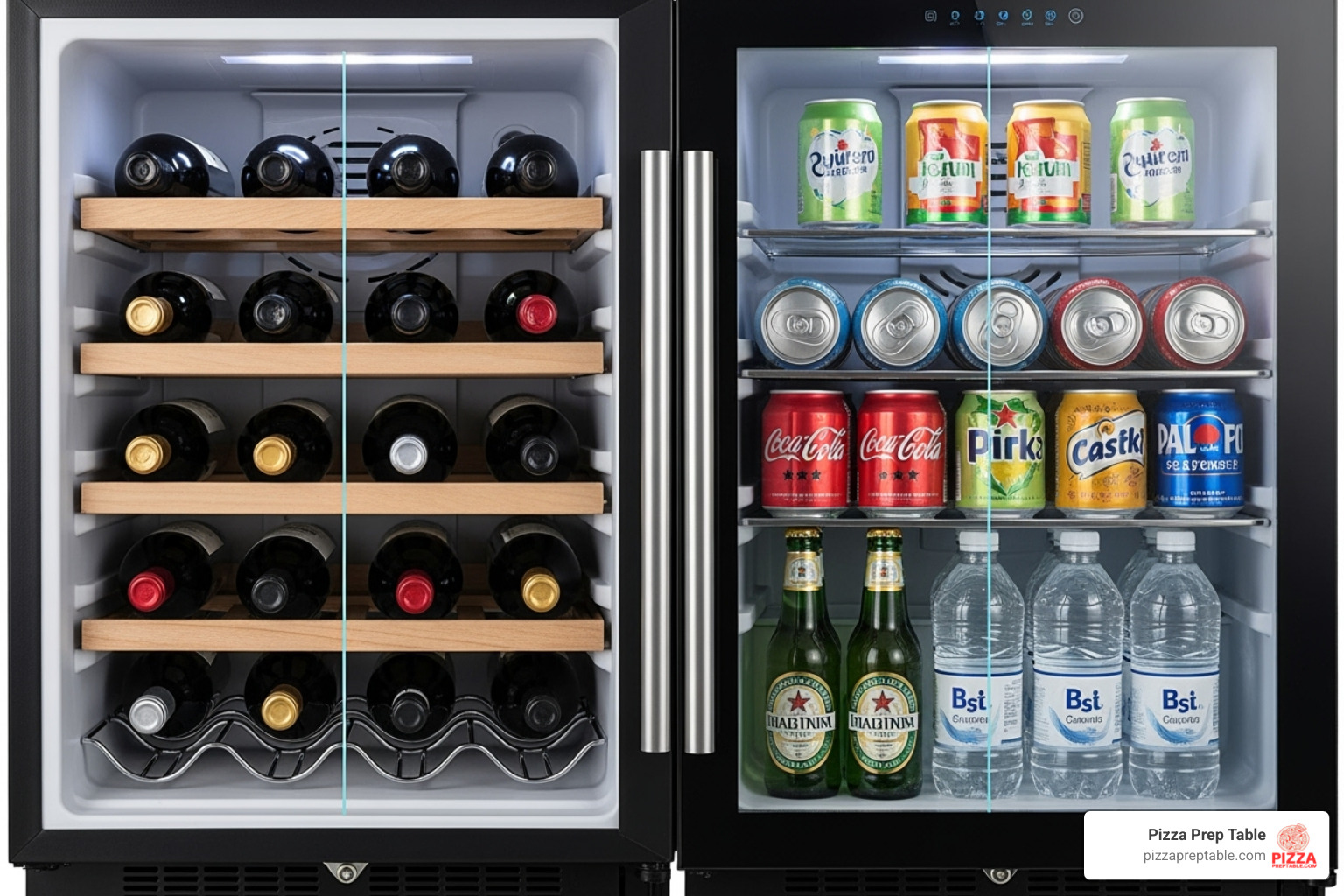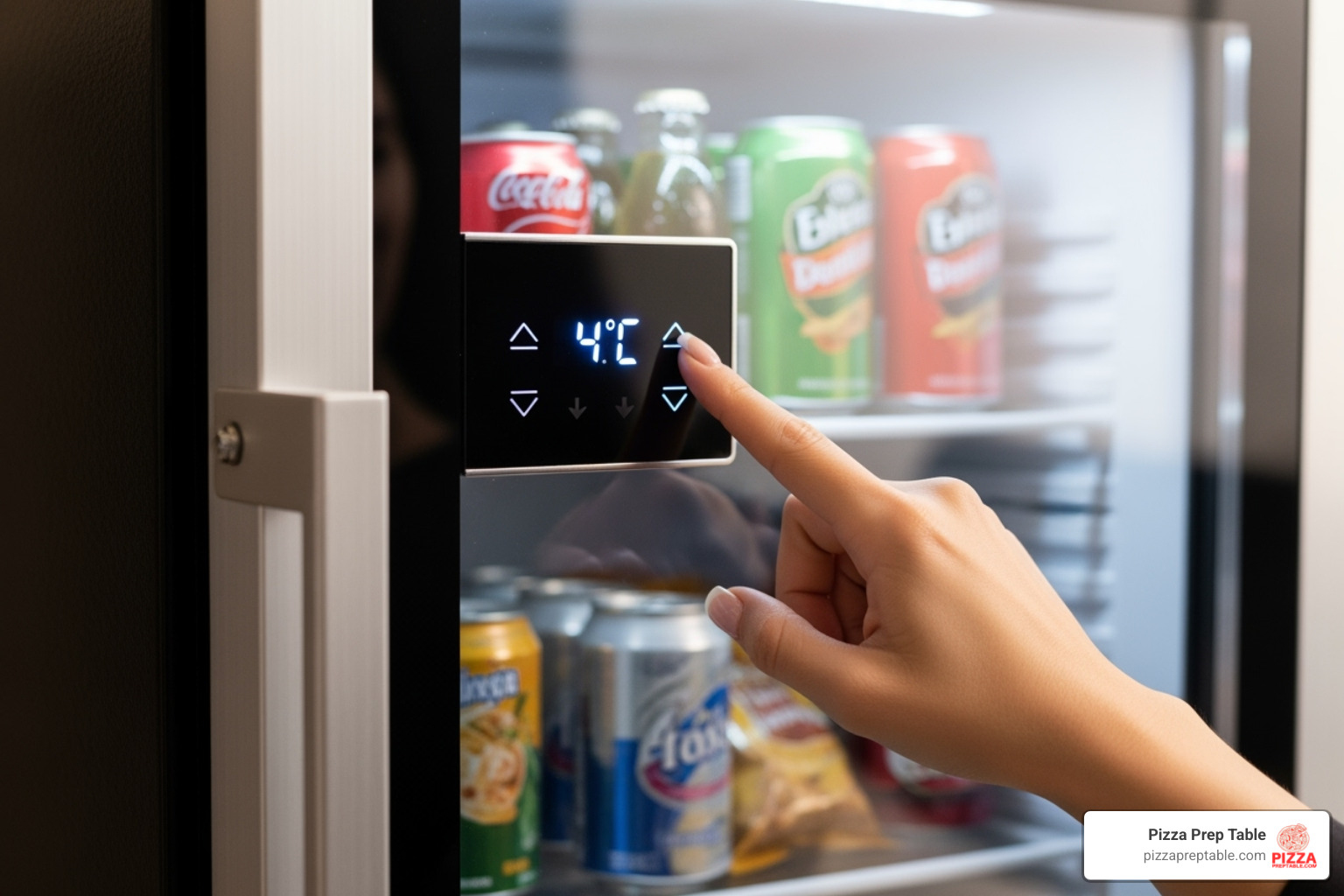
Beyond the Basics: A Roundup of the Best Mini Fridges with Glass Doors
Share
Why a Mini Fridge with Glass Door Makes Perfect Sense
A mini fridge with glass door offers the perfect combination of style and functionality for any space. Whether you're outfitting a home bar, office break room, or even a commercial kitchen, these compact coolers let you see exactly what's inside without opening the door—saving energy and keeping temperatures stable.
Top Reasons to Choose a Glass Door Mini Fridge:
- Instant Visibility - No more guessing what's inside or leaving the door open while you search
- Energy Savings - Reduce unnecessary door openings by up to 30%
- Display Appeal - Showcase your beverage collection like a professional
- Temperature Stability - Less cold air escapes when you're not constantly opening the door
- Perfect for Commercial Use - Ideal for pizza shops, cafes, and restaurants where quick beverage access matters
Based on market data, thousands of these units sell monthly, with popular models ranging from compact 50-can coolers to spacious 180-can beverage centers. Prices typically fall between $150 and $600, depending on capacity and features like digital temperature controls, LED lighting, and adjustable shelving.
The glass door design isn't just about looks. Modern units feature double-paned or UV-protected glass that maintains insulation while letting you monitor inventory at a glance. For busy commercial kitchens with limited space, this means staff can grab drinks quickly without disrupting workflow or letting precious cold air escape.
I'm Sean Kearney, and I've spent years helping restaurant owners and small business managers find equipment that maximizes both space and efficiency, including the right mini fridge with glass door for their specific needs. My experience in foodservice equipment sales has taught me that the right cooling solution can significantly improve both customer satisfaction and operational flow.
Glass Door vs. Solid Door: A Head-to-Head Comparison
Choosing between a mini fridge with glass door and a traditional solid door model is a key decision. Both styles have their place, but understanding the real-world differences can help you pick the option that fits your space and needs perfectly.
The primary appeal of glass door mini fridges is visibility. You can see the contents at a glance without opening the door, which prevents cold air from escaping while you decide. This visibility isn't just convenient—it genuinely helps with energy efficiency because you're not holding the door open nearly as long.
While older models were less efficient, modern technology has addressed this. Today's mini fridges with glass doors typically feature double-paned or even triple-paned glass with UV protection. This specialized glass provides insulation that's surprisingly close to solid doors. By reducing how often the door is opened, you can offset the slight difference in insulation, potentially saving energy overall.
| Attribute | Glass Door Mini Fridge | Solid Door Mini Fridge |
|---|---|---|
| Aesthetics | Modern, sophisticated, showcases contents, design focal point. | Traditional, blends in, less visual impact. |
| Visibility | Excellent – see contents at a glance, reduces door opening. | None – requires opening the door to see contents. |
| Energy Efficiency | Generally slightly lower due to glass, but modern double-paned/UV-protected glass minimizes loss. Reduced door opening helps offset. | Generally higher due to better insulation, but frequent opening can negate this. |
| Convenience | Quick selection, easy inventory check, ideal for display. | Requires opening to find items, less immediate access. |
| Cost | Often slightly higher due to specialized glass and lighting. | Generally lower starting price. |
| Maintenance | Glass requires more frequent cleaning to look pristine, prone to smudges. | Easier to maintain, less visible smudges. |
| Light Exposure | Contents exposed to light, can affect light-sensitive items like wine. | Contents protected from light. |
From a style perspective, a glass door instantly transforms your mini fridge from a basic appliance into a showpiece. Whether you're displaying craft beers in your home bar or keeping drinks visible in your office break room, the see-through design adds a touch of sophistication. For pizzerias and restaurants, it's an effortless way to showcase your beverage selection and encourage purchases.
The price difference is typically modest, often $50 to $100 more for glass models. You're paying for specialized glass technology and often built-in LED lighting that improves the display.
There are a couple of trade-offs. Glass doors show fingerprints and smudges more readily, so they require more frequent wiping to maintain a pristine look. And while UV-protected glass helps, particularly light-sensitive items like certain wines might fare better behind a solid door or tinted glass.
In a busy pizza shop on a Friday night, a glass door cooler allows staff to spot a customer's drink choice instantly, grab it, and maintain their workflow. With a solid door, they're opening, searching, and letting cold air escape every time. Those seconds and the energy waste add up.
If visibility, style, and display are priorities, a mini fridge with glass door is the superior choice. For maximum insulation where display is not a concern, a solid door is sufficient. However, for most home, office, and commercial settings, the glass door offers the best combination of practicality and presentation.
Our Top Picks: The Best Mini Fridges with Glass Doors
Finding the right mini fridge with glass door can be overwhelming, so we've rounded up our favorite models based on user ratings, features, value, and capacity. These picks consistently earn high praise from thousands of buyers, indicating they deliver on their promises.
Best Overall: The Versatile Beverage Center
When you need serious storage capacity without sacrificing style, a mid-sized beverage center hits the sweet spot. These fridges work beautifully in home bars, game rooms, offices, or smaller commercial settings where presentation matters.

What makes these units stand out is their generous capacity—often 100 to 120+ cans. That's enough to stock a small office break room for the week or keep guests happy on game day. The digital temperature control gives you precise settings, so your drinks are always perfectly chilled.
A popular model like the Manastin 120-Can Beverage Cooler is a top seller for several reasons. The adjustable chrome shelves let you customize the layout for bottles, cans, or even snacks. Its quiet operation won't be disruptive in living or work areas. The blue LED interior lighting showcases the contents, adding an upscale feel.
Best for Small Spaces: The Compact Cooler
Not everyone has room for a full-sized beverage center, and that's where compact mini fridges with glass doors shine. These are perfect for dorm rooms, small offices, or tucked under a counter where space is at a premium.

Most compact models range from 1.6 to 2.5 cubic feet—small enough to fit almost anywhere, yet spacious enough for essentials. The reversible door feature is a game-changer for awkward layouts. Operating at under 40 decibels, these units are quiet enough for bedrooms and offices. The removable shelf is another thoughtful touch, letting you adjust the interior for taller bottles or more cans.
Best for Wine & Beverages: The Dual-Purpose Chiller
If your tastes include both craft beers and fine wines, a dual-purpose chiller offers specialized storage for a more sophisticated collection.

The magic of these units lies in their dual-zone cooling capability. You can set one compartment to the ideal temperature for red wines (around 55-65°F) while keeping another zone chilled for whites or cold beverages (typically 40-50°F). No more compromising or needing separate fridges.
The removable wine racks make it easy to store standard bottles, and they can be taken out to make room for cans or larger containers. The UV-protected glass door is crucial here—it shields your wine from harmful light that can degrade its quality. These fridges come in both built-in and freestanding designs, offering flexible integration into your kitchen or dining room.
Key Features to Consider in a Mini Fridge with Glass Door
When choosing a mini fridge with glass door, it's crucial to look beyond aesthetics and consider the specifications to ensure it meets your needs, much like selecting commercial kitchen equipment.

Capacity is the first consideration. Measured in cubic feet or can count, this spec helps you make the right call. A compact 1.6 Cu.Ft. model holds around 50 cans, perfect for a small office. A 3.2 Cu.Ft. unit holds about 120 cans, suiting a home bar or break room. Larger 4.5 Cu.Ft. units can store 145+ cans, ideal for entertaining. Consider your typical storage needs to determine the right capacity.
For temperature control, precision matters. While manual dials are functional, digital controls offer the accuracy preferred by beverage enthusiasts, with typical ranges from 32°F to 61°F.
Energy efficiency is important for long-term savings. Look for the Energy Star certification, which indicates the appliance meets strict efficiency guidelines. The U.S. Department of Energy offers helpful tips on saving money and energy at home.
A low noise level is crucial for quiet environments. Measured in decibels (dB), most quality mini fridges operate under 40 dB, which is as quiet as a library.
Shelving options like adjustable or removable shelves offer flexibility for storing items of various sizes. Chrome wire racks are standard, while some premium models feature sleek glass shelves.
Interior lighting, usually LED, improves visibility and adds ambiance without generating heat or wasting energy.
A security lock is a valuable feature for protecting inventory in commercial settings or keeping certain beverages away from children at home.
How to Choose the Right Size Mini Fridge with a Glass Door
Always measure the intended space (height, width, and depth) before shopping to ensure a proper fit. The choice between freestanding and built-in models is also key. Freestanding units offer flexibility, while built-in models provide a seamless, integrated look.
Ventilation requirements are critical for efficiency and longevity. Most manufacturers specify minimum clearances (typically a few inches on the back and sides) to allow the unit to dissipate heat properly.
Interior layout flexibility ties back to shelving. If you store a mix of cans and bottles, adjustable shelving is your best bet. The best mini fridge with glass door models let you reconfigure the interior as your needs change.
Understanding Different Types and Price Ranges
Beverage coolers are designed to keep drinks like soda and beer at an ideal temperature, usually between 32°F and 50°F.
Wine coolers are more specialized, with temperature ranges (40°F to 65°F) that protect wine's flavor and UV-protected glass to prevent light damage. Dual-zone models allow for storing different types of wine at their respective ideal temperatures.
Price is influenced by brand reputation, capacity, features (like digital controls or dual-zone cooling), and build quality (such as stainless steel finishes). The typical price range spans from around $150 for basic compact models up to $600 or more for premium, feature-rich units. Smart shopping involves comparing models in your budget and reading user reviews to find the best value.
Frequently Asked Questions
Here are answers to common questions about choosing a mini fridge with glass door.
Are glass door mini fridges less energy efficient?
This is a common concern, but modern glass door fridges are highly efficient. While a solid door offers slightly more insulation by nature, today's mini fridges with glass doors are engineered with features that close the gap.
Most quality units now feature double-paned or even triple-paned glass, creating insulating air pockets that reduce heat transfer. Many models also include UV protection, which adds another layer of insulation.
The visibility of a glass door can also contribute to energy savings. When you can see what's inside, you open the door less frequently and for shorter periods. This behavior can reduce unnecessary openings by up to 30%, offsetting any minor difference in insulation.
The key is to look for Energy Star certification. This label means the appliance meets strict energy efficiency guidelines set by the U.S. Environmental Protection Agency. Therefore, a well-designed, Energy Star-rated mini fridge with glass door is often just as, if not more, efficient in real-world use. For more general guidance on keeping your appliances energy-efficient, check out these appliance energy saving tips from the U.S. Department of Energy.
How do I stop condensation on the glass door?
Condensation on the glass door is a common but fixable issue, caused by warm, humid air meeting the cold glass surface. First, check your room's humidity; a dehumidifier may be necessary in very humid environments like basements or commercial kitchens.
Next, inspect the door gasket seal. A dirty, cracked, or worn-out seal can let warm air in, causing condensation and forcing your fridge to work harder. Clean the gasket with mild soap and water, and replace it if you see any damage.
Some premium mini fridges with glass doors include anti-fog features like heated glass, which are useful if condensation is a persistent problem.
Finally, consider placement. Keep the fridge away from heat sources like ovens or direct sunlight. Ensure there is adequate ventilation around the unit, especially the condenser coils, as poor airflow can increase the likelihood of condensation.
What are the maintenance tips for a mini fridge with a glass door?
Maintaining a mini fridge with glass door is straightforward and key to its longevity and performance.
Start with the glass door. Keep a non-abrasive glass cleaner and a microfiber cloth handy to wipe away fingerprints and smudges. A clean glass door is essential for presentation.
Inside, periodically remove and wipe down the shelves with mild soap and warm water to prevent odors and bacteria.
The door seal is critical for efficiency. Inspect and clean it regularly to ensure a tight seal. If the gasket is cracked, torn, or brittle, replace it promptly to avoid increased energy costs.
An often-overlooked step is cleaning the condenser coils, usually located on the back or bottom of the fridge. Dust and grime force the unit to work harder, increasing energy use and shortening its lifespan. Dust the coils every few months with a vacuum's brush attachment or a coil cleaning brush.
Following these simple steps will keep your mini fridge with glass door looking great and running efficiently for years to come.
Conclusion: Finding Your Perfect Chilling Companion
So there you have it – everything you need to know to find your ideal mini fridge with glass door. We've walked through the visibility benefits, the style upgrade, the energy considerations, and the practical features that make these units so appealing. Whether you're drawn to the sleek look, the convenience of seeing your beverages at a glance, or the professional display capabilities, there's a perfect model out there waiting for you.
The key is matching the fridge to your lifestyle and space. If you're outfitting a dorm room or small office, that compact cooler with its whisper-quiet operation and reversible door might be your best friend. Planning to entertain guests regularly? The versatile beverage center with its 100+ can capacity and LED lighting will showcase your collection beautifully. And if you're a wine enthusiast who also loves cold beer, the dual-zone chiller offers the best of both worlds.
Don't overlook the practical details – measure your space twice, check those ventilation requirements, and think about which features truly matter to you. Is precise digital temperature control essential? Do you need adjustable shelves for flexibility? Would a security lock give you peace of mind? These considerations will guide you toward the right investment.
A mini fridge with glass door really is more than just a cooling appliance. It's a conversation starter, a display case, and a functional piece that can transform any space from ordinary to impressive. The transparency isn't just about aesthetics – it genuinely changes how you interact with the appliance, reducing energy waste and making your life a bit easier every time you reach for a cold drink.
For those of you running commercial operations – whether it's a busy pizzeria in Chicago, a trendy café in Los Angeles, or a neighborhood spot in New York City – we know your refrigeration needs go beyond the basics. Your equipment has to work as hard as you do, day in and day out. When you're ready to explore commercial-grade cooling solutions like undercounter refrigerators, pizza prep tables, or other essential kitchen equipment, we're here at PizzaPrepTable.com. We understand the restaurant business, and we offer both the selection and financing options to help your establishment thrive. Check out our professional options and let us help you keep your operation running smoothly and efficiently.
